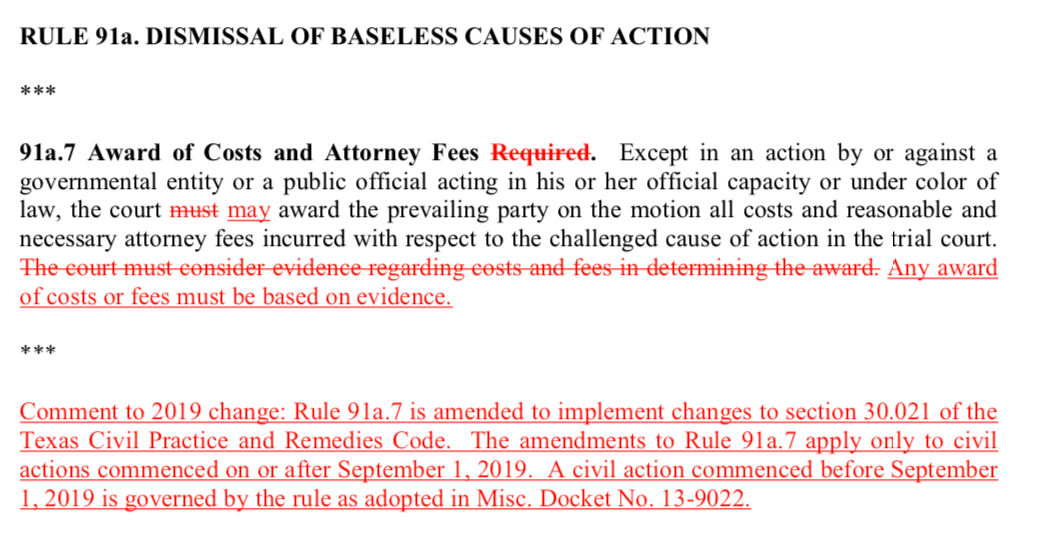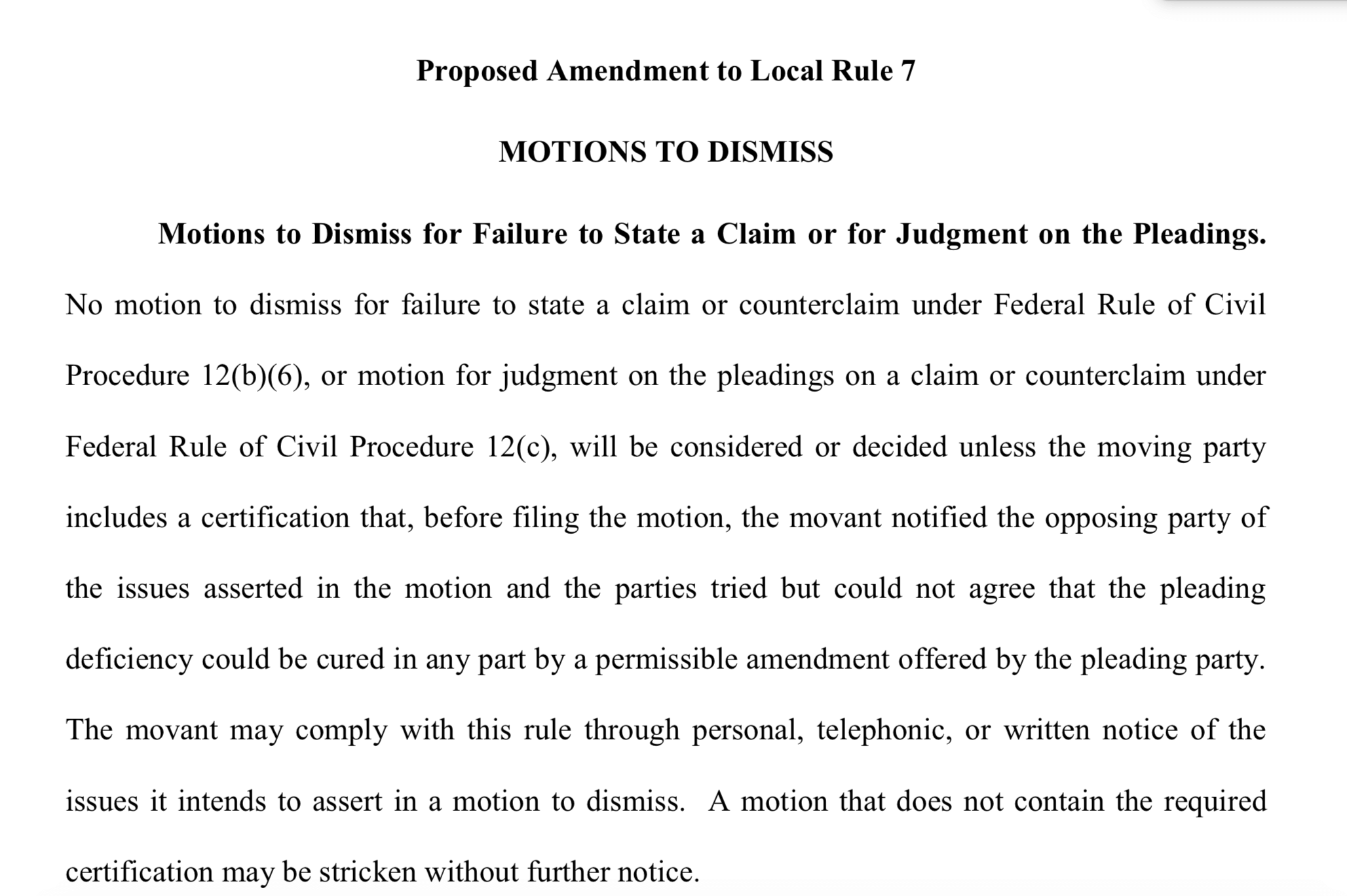What a Difference a Word Makes
Are you a Texas business, or a lawyer who represents Texas businesses? Get ready for federal-style motions to dismiss to become routine in state court litigation.
In 2019 the Texas House of Representatives passed House Bill 3300. With the change of a single word, the bill could bring the biggest change to Texas litigation practice since the adoption of the “new” discovery rules in 1999.
The bill changed Texas Rule of Civil Procedure 91a from “the court shall award costs and reasonable and necessary attorney’s fees to the prevailing party” to “the court may award costs and reasonable and necessary attorney’s fees to the prevailing party.”
This is important. It was already a big deal when the legislature originally mandated motions to dismiss in 2011, leading to the adoption of Rule 91a in 2013. For the first time, the Texas Rules authorized motions to dismiss groundless lawsuits. This moved Texas procedure closer to the more defendant-friendly practice in federal court.
But Texas defense lawyers largely refrained from filing motions to dismiss under Rule 91a. The rule had a “loser pays” provision requiring an unsuccessful movant to pay the responding party’s attorney’s fees. If you’re a defense lawyer, the last thing you want to tell your client is “sorry, we lost the motion and you’re going to have to pay the other side’s attorney’s fees.”
The new version of Rule 91a passed by the House changed that. It gives the judge discretion not to award attorney’s fees, making defendants much more likely to file motions to dismiss.
Want proof? Just look at all the motions to dismiss filed under the Texas Citizens Participation Act (TCPA), also enacted in 2011. That statute authorized motions to dismiss in certain cases but did not require the moving party to pay attorney’s fees if the judge denied the motion. This resulted in a tsunami of TCPA motions. More about that later.
To appreciate the significance of the change to Rule 91a, let’s back up a bit. Since the Swing Era, Federal Rule of Civil Procedure 12(b)(6) has allowed a defendant in federal court to file a motion to dismiss the plaintiff’s lawsuit for “failure to state a claim upon which relief can be granted.” This means you can ask the judge to dismiss a lawsuit—in whole or in part—on the ground that the plaintiff’s pleading on its face fails to state a valid legal claim. Most states have a similar rule.
But not Texas. Prior to Rule 91a (and the TCPA), a “motion to dismiss” was not even a thing under the Texas Rules of Civil Procedure.
There were some exceptions. You could file a motion to dismiss on the ground that Texas did not have jurisdiction over an out-of-state defendant. You could file “special exceptions” asking the court to dismiss a particular cause of action because Texas law doesn’t recognize it (like negligent infliction of emotional distress).
But outside of a few narrow exceptions like these, Texas procedure did not provide for a “motion to dismiss.”
This led to interesting conversations with non-Texas lawyers. Let’s say a New York law firm hired you as local counsel in a lawsuit filed in state court in Hidalgo County. “Should we consider filing a motion to dismiss?” the New York lawyer would ask. “Uh, we don’t really have motions to dismiss here,” you would say. “What?! That’s crazy!”
But in historical context, it was not so crazy. The absence of motions to dismiss was part of a broader Texas philosophy that every plaintiff should get his “day in court.” Traditionally, Texas law has been hostile to procedures designed to short-circuit jury trials. As the proverbial courthouse sign said, “No Spittin’, No Cussin’, and No Summary Judgment.”
Of course, that all started to change around the 1990s, with “tort reform” legislation and Republicans taking over the Texas Supreme Court. The direction of Texas law for the last three decades has been largely “pro-business” and anti-litigation. We want fewer lawsuits, and we want to dispose of them faster.
Rule 91a and the TCPA were in a sense just the latest wave in a broad effort to reign in what is seen as lawsuit abuse.
“Frivolous” Lawsuits
Is this a good thing? In theory, yes. But in practice, Rule 91a and the TCPA are trying to solve a problem that is largely unsolvable: how to quickly and inexpensively dispose of the non-frivolous nuisance case.
You may be thinking that “non-frivolous nuisance case” is an oxymoron. But it’s actually quite common. Let me explain.
First we need to distinguish between a “frivolous” lawsuit and a nuisance lawsuit.
A frivolous lawsuit is the inmate claiming the prison cafeteria violated his civil rights by taking pepper steak off the Thursday night menu. It’s unreasonable on its face.
And Texas never needed a new motion to dismiss procedure to combat frivolous lawsuits. Texas already had two procedures—one in Rule 13 of the Texas Rules of Civil Procedure, the other in Chapter 10 of the Texas Civil Practice and Remedies Code—providing remedies for genuinely groundless lawsuits. But those procedures are rarely used, precisely because so few lawsuits are actually frivolous.
Most of the public doesn’t get this. They think frivolous lawsuits are common. But in over 20 years of Texas litigation practice, I don’t think I’ve had a single one.
By the way, the famous McDonald’s hot coffee lawsuit was not frivolous. I mean, reasonable people can disagree about whether McDonald’s should have been liable for keeping its coffee too hot, but the claim wasn’t frivolous. The lady wasn’t claiming she didn’t know coffee is hot. Google it.
When you think about it, it’s not surprising that frivolous lawsuits are rare. How many people are going to pay hundreds of dollars an hour (at least) to have a lawyer draft and file a lawsuit that has no real chance of winning? Or how many lawyers working for a one-third cut of the recovery are going to waste their time filing a lawsuit they know will ultimately fail? Not many.
But wait, the savvy public says, you’re ignoring the fact that defendants will pay money to settle frivolous lawsuits so they don’t have to pay their lawyers to defend them. That’s why such lawsuits get filed.
Oh really? How many times have you actually seen that happen? How many insurance companies do you know that, when served with a frivolous lawsuit, say “let me get out my checkbook, how much money would you like?”
No, businesses and insurance companies are not falling over themselves to pay off plaintiffs who file groundless lawsuits. If they did, it would only encourage more.
The Problem of the Non-Frivolous Nuisance Lawsuit
Nuisance lawsuits are different. Defendants do pay to settle nuisance lawsuits, on the theory that it’s cheaper to pay a settlement than to pay your lawyer to litigate. Lawyers sometimes call these “cost of defense” settlements. And these cases are quite common.
But how are these nuisance lawsuits any different from the frivolous ones?
The difference is that a nuisance lawsuit has at least some grain of truth to it. That grain may be that if you accept the plaintiff’s allegations as true, there is at least some reasonable legal argument that the plaintiff is entitled to relief from the court. Or it may be that there is at least some evidence to support the allegations made by the plaintiff, even if nine out of ten juries would vote for the defense.
While I’ve never seen a truly frivolous lawsuit in my practice, I’ve seen plenty of nuisance lawsuits. Here are some examples, drawn from my actual experience plus a little imagination:
- A homebuilder sues a competitor for copyright infringement because the competitor used a floor plan that bears numerous similarities to a floor plan the homebuilder created. The floor plan has unique features such as a large living room with a high ceiling adjacent to an open kitchen.
- An employee of an oilfield services company never signs a non-compete, but when he leaves to join a competing company, his original employer sues for misappropriation of trade secrets, claiming the employee has knowledge of the company’s confidential customer list, which consists of oil and gas operators.
- A consultant who was fired a couple months into his one-year contract claims he is owed an entire year of pay, when the contract expressly gave the client the option to terminate early.
These cases have two things in common: they are weak, but they are not entirely groundless.
What’s Wrong with Motions for Summary Judgment?
It’s hard to represent a defendant in this kind of lawsuit, because your client is so frustrated. “Zach, I don’t understand, why can’t we just tell the judge this claim is ridiculous?”
The problem, of course, is that lawsuits are about disputes. If we had some surefire trick to separate the good guys from the bad guys, we wouldn’t need judges, juries, and complicated rules of procedure and evidence.
“But Zach,” my client will say, “don’t they need evidence to back up their claims?” “Why can’t we tell the judge they have no evidence?”
The answer is yes, they have to have evidence, and yes, there is a procedure to tell the judge they don’t have any evidence. It’s called summary judgment. Like the Federal Rules, the Texas Rules of Civil Procedure allow a defendant to file a motion for summary judgment on the ground that there is no evidence to support the legal elements of the plaintiff’s claims. See Texas Rule 166a(i).
The benefit of a motion for summary judgment is that it avoids the time and expense of a trial. If the evidence doesn’t raise any genuine factual dispute, the judge can dispose of the case by summary judgment.
So what’s the catch? Why doesn’t summary judgment solve the problem of the non-frivolous nuisance case?
In a word: discovery.
Traditionally, the plaintiff has been entitled to take discovery before the court rules on a motion for summary judgment. Discovery includes production of documents, written answers to interrogatories, and depositions. If you’ve ever been in a lawsuit with the slightest level of complexity, you know that 90% of the time and expense is for discovery.
Oh, and there was a development around the 1990s that made the discovery process even more complicated and expensive. It was a little innovation called email.
Now the full context of Rule 91a and the TCPA is coming into focus. Discovery is time-consuming and expensive, and the proliferation of email has only made it worse. The procedures for dismissing frivolous cases (Rule 13 and Chapter 10) are not much help because so few cases are actually frivolous. The procedure for summary judgment doesn’t solve the problem because the plaintiff is usually entitled to take discovery first.
This is why people thought a Texas version of Federal Rule 12(b)(6) was necessary. You need a procedure for weeding out nuisance lawsuits before the discovery process. That’s what will cut down on the time and expense of litigation.
The Law of Unintended Consequences
Those of you who practice litigation already see where this is headed. Does a motion to dismiss procedure actually reduce the time and expense of litigation? Let’s consider a couple data points.
First, we need look no further than federal court to test the hypothesis. Here we have to be careful about our sample. We should exclude, for example, securities fraud cases. Motions to dismiss are the big event in securities fraud class actions. But there’s a special reason: Congress passed a heightened pleading standard that, essentially, requires a plaintiff to allege specific facts showing that the CEO knew he was lying when he said on the analyst call “we think the environment for our expansion into Brazil is looking positive.”
That’s unusual. In an ordinary federal case, all the plaintiff has to do is allege sufficient facts to establish a plausible basis for relief. And when a motion to dismiss is filed, the judge must assume for the purpose of the motion that those factual allegations are true. That means the vast majority of federal motions to dismiss get denied.
Mind you, this doesn’t stop lawyers from trying. BigLaw firms, especially, really like motions to dismiss. Drafting a motion to dismiss is the perfect project to assign to a less experienced litigation associate, who will then research the legal standards at issue, analyze whether the plaintiff’s pleading meets those legal standards, and draft the motion. That’s good for 5-10 billable hours (at least), not to mention the partner’s time for reviewing and revising the draft motion.
Then the plaintiff’s lawyers do the same type of thing to respond to the motion, the defense lawyers draft a reply to the response, the plaintiff’s lawyers sometimes file a “sur-reply” to the reply, the judge might hold a hearing, etc.
Bear in mind that the judge is going to deny the motion. I learned this years ago in a case before U.S. District Judge Sam Sparks. We thought there was a strong argument that one of the plaintiff’s state-law causes of action, on its face, was preempted by federal copyright law.
At a hearing Judge Sparks gruffly asked me, “why should I rule on this issue on a motion to dismiss instead of waiting for a motion for summary judgment?” My answer, in a word: discovery. I told him my client should not have to bear the expense of discovery regarding a claim that was legally defective. “Ok, you’ve got a decent point there,” he said. “Motion denied.”
That kind of shows you how much Rule 12(b)(6) has reduced the time and expense of litigation in federal court.
But could the new Rule 91a be different in state court?
Again, we don’t have to speculate, because we have some data from a similar experiment. Remember the TCPA? It allows a defendant to file a motion to dismiss in certain kinds of cases (essentially any case where the claim is based on a defendant’s “communication” about a good or service). The plaintiff then has to offer evidence to support every element of his claims, before taking any discovery. So, the TCPA essentially functions as a pre-discovery motion for summary judgment.
A pre-discovery motion for summary judgment. Hallelujah! That’s exactly what we’ve been waiting for to combat the problem of the non-frivolous nuisance lawsuit.
But did the TCPA reduced the time and expense of litigation? Let me put it this way: I gave some presentations on the TCPA, and when I posed this question to a roomful of lawyers, it was sure to get big laughs.
They laughed because the last thing the TCPA did was to reduce the amount of litigation. On the contrary, I’ve heard people call the statute a full employment act for appellate lawyers. Just look at the number of appellate decisions grappling with the TCPA.
One more anecdote will make the point plain: I called the court clerk in one of my cases to schedule a hearing on a motion. His first question: is this a TCPA motion?
No, the TCPA did not reduce the time and expense of litigation. So now, when you call the court clerk asking for a hearing, will she say in a knowing monotone, “is this a Rule 91a motion?”
*Update: HB 3300 passed and was signed into law, with an effective date of September 1, 2019. See Tex. Civ. Prac. & Rem. Code § 30.021. In this Order, the Texas Supreme Court accordingly amended Rule 91a.7 as follows: 
*Further Update: Want evidence that federal courts already have “motion to dismiss fatigue”? Check out this proposed local rule in the Southern District of Texas that would require lawyers to confer before filing a Rule 12(b)(6) motion: 

Zach Wolfe (zach@zachwolfelaw.com) is a Texas trial lawyer who handles non-compete and trade secret litigation at his firm Zach Wolfe Law Firm (zachwolfelaw.com). Thomson Reuters has named him a Texas “Super Lawyer”® for Business Litigation every year since 2020.
These are his opinions, not the opinions of his firm or clients, so don’t cite part of this post against him in an actual case. Every case is different, so don’t rely on this post as legal advice for your case.




Comments:
I have a case against a bank that did a loan modification without my signature. My ex-husband was awarded the house in our divorce. He was delinwquent with payments and applied for a modification. I am in the military which makes the house a VA loan. The bank filed a rule 91A with incorporated memorandum of law. What are my chances of prevailing?
Thanks for reading and for your question. This one is impossible to answer without taking a detailed look at the facts and the pleadings. Do you have a lawyer in your case? Feel free to email me back at zwolfe@fleckman.com.
I enjoyed reading this article. You have a talent for making such dry subject matter, like civil procedure, accessible and compelling. I like your distinction between frivolous and nuisance cases. I also hate it when the judge, or opposing counsel, agrees with your argument and you still get burned.
Thanks, Paul! Yeah, you have to watch for the “head fake” when the judge starts agreeing with your argument.
Thank you for this article. It is well written and informative.